What Can I Take for Elbow Pain
What is elbow pain?
Most elbow pain has a very simple cause and clears up within a few days. The pain usually comes from strained or inflamed soft tissues such as tendons. You can normally treat this pain yourself with over-the-counter painkillers and a few days' rest, and you may not need to see your doctor.
It's important not to rest for too long as lack of movement causes your joint to stiffen and the muscles around your elbow to weaken, which increases the chance that you'll have further symptoms. Simple exercises can help to reduce the risk of future problems. Long-term elbow pain can be caused by arthritis.
How does the elbow work?
The elbow joint is where the long bone at the top of your arm, known as the humerus, meets the two bones in your forearm – called the radius and the ulna. It's a hinge joint, and it allows you to bend your arm. The upper part of the radius can rotate so you can twist your forearm.
The end of the humerus has two bony parts that you can feel at either side of your elbow. These are:
- the lateral epicondyle on the outside of your arm
- the medial epicondyle on the inside of your arm.
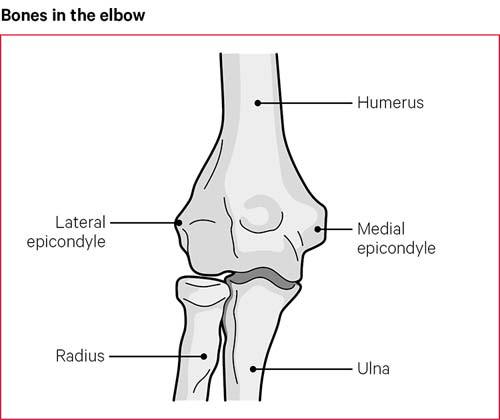
Muscles attached to the outside of the humerus help you straighten your wrist and fingers. These are connected to the brain and nervous system through the radial nerve, which travels on the outside of the elbow.
Muscles attached to the inside of the humerus help you bend your wrist and fingers, and let you grasp objects. These muscles are connected to the brain and nervous system through the median nerve, which runs in front of the elbow.
The ulnar nerve, which is on the inside of the elbow is mainly responsible for the movements of the small muscles of the hand. These are useful for precise and delicate hand movements. The feeling of hitting your funny bone is caused by the ulnar nerve being pinched.
There are also strong cords in the elbow that help to hold the joint in place. Tendons attach muscles to bones and ligaments link bones together.
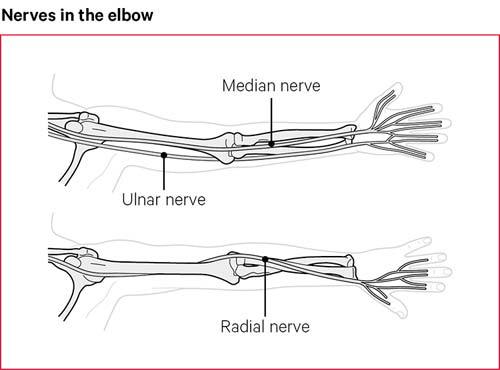
Causes
Most cases of elbow pain are due to strained or inflamed soft tissues such as tendons or ligaments.
These tend to get better after a few days with simple self-care you can do at home.
Sometimes elbow pain may be caused by a medical condition.
A number of things can cause stiffness in your elbow, including arthritis (arth-rye-tus). Arthritis simply means a joint that is painful and swollen, and there are a number of types of arthritis.
Stiffness can happen due to problems with the elbow joint itself or with the muscles, covering of the joint, or ligaments.
In some situations, such as after an injury or operation, soft tissue can form into scar tissue. This can cause elbow stiffness.
Occasionally, the elbow may lock in a fixed position. This is often short-lived but may be due to a loose bit of bone or cartilage in the joint. The loose fragments may need to be washed out in surgery.
Arthritis of the elbow
The elbow can be affected by various types of arthritis.
Osteoarthritis is the most common form of arthritis. It starts with the loss of cartilage, which is a thin protective layer that covers bones in a joint. In response the body can grow bony spurs within the joint and there can be an increase of fluid in the joint space. This can happen without you feeling any symptoms. But it can cause pain, swelling and stiffness in a joint.
Osteoarthritis is not very common in the elbow unless you've injured it in the past, for example if you've previously broken a bone.
The following types of arthritis can also affect the elbow:
- rheumatoid (roo-ma-toyed) arthritis – an autoimmune condition that can cause pain and swelling in joints. Joints can be red, hot, stiff and tender to touch. Autoimmune conditions are caused when your immune system, which normally protects you from illness and infection, gets confused and mistakenly attacks the body's healthy tissue.
- psoriatic (sorry-atik) arthritis – an autoimmune condition associated with the skin condition psoriasis (so-rye-a-sis), that causes patches of red, raised skin with white or silvery flakes. It can cause pain and swelling in and around joints.
- gout – a type of arthritis that causes pain and swelling in joints. It's caused by a build-up of crystals of the waste product urate in the joints. Affected joints can be very painful, and the skin can sometimes be red and shiny.
When to see a doctor
Most cases of elbow pain will get better on their own or with simple self-help treatments. You should see a doctor if:
- your pain doesn't improve after two weeks of taking painkillers and resting your elbow, and you haven't had an injury or infection
- you have tingling, numbness or weakness in your arm or hand.
You should visit a hospital's accident and emergency department straight way if:
- you notice symptoms such as severe pain that stops you from moving your arm, swelling, fever, heat and redness. These can sometimes be signs of infection.
- you think you've fractured your elbow – this will probably follow an obvious injury such as a direct impact or fall onto an outstretched hand. A fracture will cause pain and usually bruising and swelling.
Managing symptoms
There are several ways you can help yourself if you have elbow pain. These include taking painkillers, applying heat or ice packs, changing your movements and exercising.
Changing how you move
The first thing to do if you have elbow pain is to change, or possibly stop, any movements that might be causing your symptoms or making them worse. Flare-ups of some conditions, where the symptoms become suddenly worse, can be eased by avoiding bending the elbow into certain positions.
If you do any tasks for work that involve repetitive movements such as using a screwdriver or painting, it's worth discussing this with an occupational therapist. These are healthcare professionals who can suggest how to change your movements and ways to support your elbow while it's healing.
A GP can refer you to an occupational therapist, or you can see one privately.
If your workplace has an occupational health department, they should be able to help.
Drugs to reduce pain
Painkillers, such as paracetamol may help to ease pain. You should use them as and when you need them, but it's best to take them before the pain becomes very bad.
Non-steroidal anti-inflammatory drugs (NSAIDs) are a group of drugs that can help ease pain, swelling and stiffness. A common NSAID is ibuprofen, which you can buy at chemists and supermarkets.
If you have stomach problems after using pain relief or NSAIDs, you should stop taking the tablets and see your doctor. There are also anti-inflammatory creams or gels you can rub onto your elbow, which don't cause stomach problems.
Splints
For some conditions, such as tennis elbow, using a splint to support your elbow may ease the strain when you're doing certain activities that cause it to flare up. They're available from chemists, sports shops and physiotherapists. They're also known as epicondylitis clasps. Ask a healthcare professional or a pharmacist if a splint would help you, and when and how you should wear it.
![]()
Heat or ice packs
Placing a heat or ice pack to your elbow for 10 to 15 minutes every few hours can ease pain and stiffness. You can use a reusable pad, a microwavable wheat bag or a hot water bottle. A bag of frozen peas can also be helpful if you don't have an ice pack.
Make sure you don't put either a heat or an ice pack directly onto your skin, as this could burn or irritate it. You should wrap them in something like a tea towel first.
Heat encourages blood to flow to a part of the body, and this can ease stiffness, encourage recovery of damaged tissue, and relieve pain. Don't apply heat to your elbow if it's swollen or if you've just injured it, as this can make it worse.
Ice reduces blood flow to part of the body, and this can reduce swelling.
People sometimes find that alternating between heat and ice throughout the day can help. Experiment and see what works best for you. Talk to a GP or pharmacist if you have any questions or concerns.
Exercises
To prevent your elbow joint stiffening and your arm muscles weakening it's best not to rest for more than a few days. Start some gentle exercise as soon as the pain begins to ease. Simple exercises can help restore your range of movement, maintain your strength and ease stiffness.
We have some examples of simple stretching and strengthening exercises.
Start by exercising very gently and gradually build up the amount you do. It's normal to feel muscle ache after exercise but stop if you get any joint pain that doesn't go away quickly.
A GP or physiotherapist can give you advice on exercising.
Diagnosis
Most elbow problems can be diagnosed and treated after a simple examination, and it's unlikely you'll need to have any special tests.
Your doctor may suggest you have an X-ray, which can show any new bone growth, any small pieces of loose bone, or arthritis.
Very rarely an ultrasound scan or a magnetic resonance imaging (MRI) scan may be needed to rule out or confirm a diagnosis.
In an ultrasound scan a small device is placed on the skin. Sound waves create an image of part of the inside of the body.
Someone having an MRI scan will need to lie in a large tube, and magnetic fields and radio waves produce detailed images of the inside of the body.
You may need a nerve conduction test if you've been having problems with your nerves. Small electrodes are placed on your skin to stimulate nerves. This will measure how fast messages are sent through the nerve, and the length of delay will give an idea of how badly the nerve is being squeezed.
Treatments
Self-help treatments and a few days' rest are often enough to clear up a spell of elbow pain.
If you have a soft-tissue condition such as tennis elbow or golfer's elbow, stopping the activity that caused it in the first place is important. This should dramatically improve your symptoms.
If you have a more complex or persistent problem, your doctor will be able to recommend other treatments and therapies.
Physical therapies
Physiotherapy may be useful to help build up the strength in your elbow and prevent the condition returning.
Physiotherapists are trained specialists who can help people with an injury or long-term health condition be active and independent.
Your physiotherapist will help you keep up or regain flexibility in your elbow through exercise. You should stretch out your elbow at least once a day and do general range-of-movement exercises. Your physiotherapist might also recommend biceps and triceps strengthening exercises with light weights or resistance bands.
An occupational therapist can identify movements that may be causing discomfort. They can look at activities you find difficult and see if there's another way you can do them so you can maintain daily living and working skills.
Steroid injections
If you're in severe pain your doctor may suggest a steroid injection. The pain can become worse for a few hours afterwards but then usually fades.
For some conditions steroid injections can have an effect on symptoms for a short term. Depending on what type of steroid injection you've had they may start to wear off after about six weeks.
If you have a type of inflammatory arthritis that's affecting the elbow, such as rheumatoid arthritis or psoriatic arthritis, your specialist may inject the joint as part of your treatment.
Steroid injections aren't recommended for tennis or golfer's elbow. They can cause these conditions to be worse in the long term.
Platelet-rich plasma injections
A technique called platelet-rich plasma (PRP) injections is becoming increasingly popular for tennis and golfer's elbow. Platelets are cells in the blood that perform a number of roles, including helping the blood to clot if you cut yourself.
This treatment is usually performed in hospitals by orthopaedic specialists. It involves taking a blood sample from you, which is then treated to increase the number of platelets. This is then injected into the painful area.
Recent studies have shown that PRP may reduce pain and increase movement more effectively than steroid injections. This is not yet available in all hospitals in the UK.
Surgery
Most cases of elbow pain will heal using the treatments above, but a small number of people will need surgery to ease their symptoms. There are different types of elbow surgery depending on what condition you have. There are examples of types of surgery for specific elbow conditions detailed below.
Most operations are carried out as day-case procedures and you'll be able to go home the same day.
You'll need to talk with your doctor and hospital team about the benefits and disadvantages of surgery for you.
If your stiffness is caused by the growth of new bone or soft tissues shortening, you may need an operation to remove the bone or release the tension in the shortened tissues. After the operation, you'll need physiotherapy.
If loose pieces of bone are causing pain, they can be removed with keyhole surgery. This means the operation can be done through a small cut or incision, so the joint doesn't have to be opened up. This type of operation is also known as arthroscopy.
If necessary, bits of bone can be removed from the joint in an open surgical procedure, through a bigger incision.
If arthritis of the elbow is making it difficult for you to carry on with your daily life or is causing a lot of pain and restricting your movement, an elbow replacement may be an option.
Specific elbow conditions
Some of the specific conditions that affect the elbow include the following:
Tennis elbow and golfer's elbow
Tennis elbow and golfer's elbow are two separate but similar conditions in which tendons become painful. Anybody can develop them, but they're most common between the ages of 40 and 50. Tennis elbow is the more common of the two conditions.
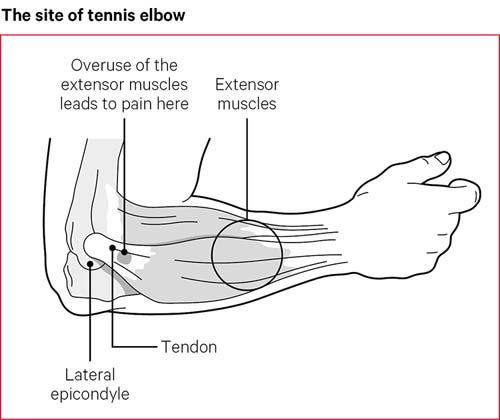
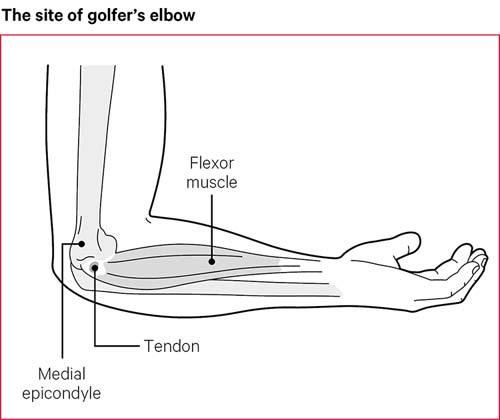
Despite their names, playing tennis or golf aren't the most common causes. They're overuse injuries linked with activities involving repetitive actions of the wrist and hand.
People who are continually gripping and twisting – for example carpenters and plasterers, or people who use a computer mouse – may be at risk. Repetitive actions combined with weight, for example lifting heavy boxes, can also cause these problems.
Tennis elbow affects tendons on the outside of the elbow. Golfer's elbow affects tendons on the inside of the elbow.
Symptoms
The main symptoms are pain and tenderness – on the outside of the elbow for tennis elbow, and on the inside for golfer's elbow. People may also have pain when gripping.
The level of pain can vary from person to person, ranging from a mild discomfort to a severe ache that prevents you from sleeping.
Often all that's needed is to stop or change any activities causing the problem or making it worse, alongside some self-care steps you can do at home.
Both conditions can last between six months and two years. Most people get better within a year. Unfortunately, they can both return.
Surgery for tennis and golfer's elbow
Surgery is only needed for a small number of people with these conditions. These operations can be done using keyhole surgery or through a cut about 4 to 5 cm long. You should be able to start using the elbow gently straight after these operations, but it will take several weeks to fully recover, and you'll usually need a short course of physiotherapy.
Olecranon bursitis
Olecranon bursitis occurs when the bursa at the back of the elbow becomes swollen and inflamed. Bursae, which is the plural for bursa, are sacs of fluid found where parts of the body move over one another, for example where tendons or ligaments pass over bones. They help cushion the area and reduce friction.
The olecranon is the bony tip you can feel on your elbow. It has a bursa between the bone and the skin.
Olecranon bursitis most commonly occurs when there is pressure or friction over the back of an elbow, for example if you often lean your elbows on a chair or table. For this reason, this condition is sometimes called student's elbow.
Symptoms
The main symptoms of olecranon bursitis are:
- swelling, pain and warmth over the bony part at the back of the elbow
- restricted movement of the elbow.
Occasionally, bacteria can cause the bursa to become infected. Olecranon bursitis often clears up on its own, but if the condition is caused by an infection, your doctor will prescribe a course of antibiotics.
Resting your elbow and applying ice packs can help. If this doesn't work, talk to your doctor about other treatment options. This may include a healthcare professional draining fluid with a syringe. This treatment is called aspiration.
Surgery for olecranon bursitis
A small number of cases may need surgery if this condition keeps coming back or affects everyday activities. The operation involves removing the bursa through a cut at the back of the elbow. Some surgeons have recently started to use keyhole surgery for this procedure.
Compression or entrapment syndromes
If the nerves that travel across your elbow into your forearm are squeezed or pressed on, it can cause symptoms in your forearms, wrist or hands including:
- pain
- tingling in the fingers and hands
- weakening of your muscles.
These are called compression or entrapment syndromes.
Cubital tunnel syndrome
Cubital tunnel syndrome is caused by the ulnar nerve being squeezed where it passes the inside of the elbow. This can be due to the space it passes through becoming tighter than usual.
In rare cases, it can be due to arthritis. Other causes can include a fracture around the nerve which has healed into a different position or new bone growing when the fracture heals.
Symptoms
The main symptoms of cubital tunnel syndrome are:
- tingling and numbness of your ring and little finger after your elbow has been bent for long periods or after you've been resting on the inner edge of your elbows
- weakness of the small muscles of your hand, causing your ring and little fingers to become claw-like – this only happens if it's left untreated.
Radial tunnel syndrome
Radial tunnel syndrome is similar to cubital tunnel syndrome but is caused by the radial nerve being pressed on below the elbow. It's a rare condition.
Radial tunnel syndrome normally gets better on its own.
Symptoms
The main symptom of radial tunnel syndrome is pain starting from the outside of the elbow that runs down to the forearm. Because this type of pain also occurs in tennis elbow the two can be confused, but with radial tunnel syndrome there's no tenderness on the outside of the elbow – the problem is further down the arm.
Treatments for cubital and radial tunnel syndromes
A physiotherapist will be able to tell you about the best exercises for you.
Most cases can be treated at home by:
- stopping or changing movements that are aggravating your symptoms
- applying ice – such as a bag of frozen peas wrapped in a tea towel
- taking painkillers
- wearing a splint to support it – a GP, pharmacist or physiotherapist will be able to give you advice on the best ones to wear.
If your symptoms don't get better after a few weeks, or if your pain is bad, see a doctor.
A small number of people will need surgery for these conditions. The operation involves making a cut to find the affected nerve, which is then freed from the tissues that are pressing on it. You can use your elbow for activities that don't involve heavy lifting straightaway and continue with other tasks as your pain allows.
Distal biceps rupture
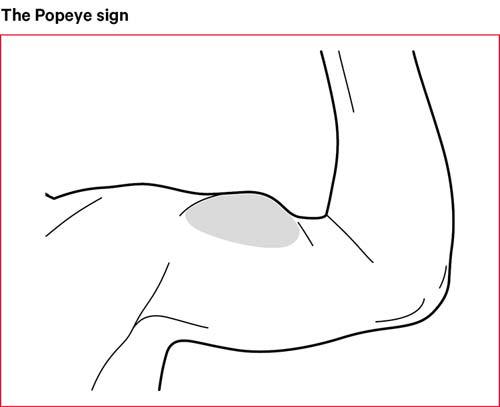
The bicep is the large muscle at the front of the upper arm. Its upper (proximal) end is attached at the shoulder and its lower (distal) end is attached to the upper part of the radius by a tendon close to the elbow joint. A distal biceps rupture is caused if this tendon close to the elbow tears, which can happen if you've lifted a heavy weight. You may hear the tendon snapping.
Symptoms
The symptoms of a distal biceps rupture are:
- a sudden and severe pain in the elbow, which gradually eases
- bruising around the elbow and forearm within a few hours or days after the injury first occurred
- the bicep changing shape and shifting up towards the shoulder – this is commonly called the Popeye sign
- difficulty in twisting the forearm to turn the palm upwards, for example when turning a door handle or using a screwdriver – your arm will feel weak compared to the unaffected arm when doing this.
A similar condition can occur in the triceps, the muscle at the back of the arm. This is called a distal triceps rupture and it can cause pain and swelling at the back of the elbow, and reduce movement. It's very rare, but it can be caused by falling onto an outstretched hand.
Treatment for distal biceps rupture or triceps rupture
If you think you have a distal biceps rupture or a triceps rupture you should seek medical attention as soon as possible. These conditions may require urgent surgery to prevent permanent damage to your arm. You should either go to an accident and emergency department or book an urgent appointment with your GP.
Surgery may be recommended depending on your level of activity and whether your activities need you to twist your forearm. This operation involves making a cut over the front of the elbow and fixing the torn tendon back onto the radius.
Research and new developments
Research is helping to increase our understanding of how elbow pain develops and identify the best ways to treat it.
Our research has found that cortisone, a steroid which is often given to treat tendon pain, can cause tendon damage by prematurely ageing tendon cells. These findings will hopefully lead to new treatments for tendon pain, such as golfer's elbow.
Our research has also found that although rest is commonly recommended for people with lower arm pain, remaining active while waiting for physiotherapy is better for reducing symptoms.
We are currently funding research projects looking at how tendons, such as those in the elbow, become damaged and how cells in the tendon help with repair following this. This will allow our researchers to better understand how tendon pain develops in conditions such as tennis elbow and golfer's elbow and find new and effective ways to treat it.
What Can I Take for Elbow Pain
Source: https://www.versusarthritis.org/about-arthritis/conditions/elbow-pain/
0 Response to "What Can I Take for Elbow Pain"
Post a Comment